Following is from a report in Business Standard.
Ivy League colleges – Yale, Harvard, Princeton and the Massachusetts Institute of Technology – have approached the ministry of human resources development to collaborate in the proposed Innovation Universities across the country, official sources said.
These universities are a part of the ministry’s “brain gain” policy to attract talent from all over the world. Human Resources Development Minister Kapil Sibal had last August announced that 14 Innovation Universities will be set up in the country under the 11th Five-year Plan (2007-12).
During his visit to the US in October, Sibal had met senior functionaries of three top universities – Harvard, Yale and MIT – and had discussed the prospects of them setting up Innovation Universities in India in partnership and collaboration with Indian institutions.
Sam Pitroda, the well-known technocrat and the head of the National Knowledge Commission, is learnt to be drafting the details for establishing the Innovation Universities. “Pitroda will soon meet Prime Minister Manmohan Singh and discuss the matter. An announcement on the details could come up during the Republic Day ceremonies,” said a source close to the development.
The ministry is also looking at public-private partnerships for establishing some of the Innovation Universities. This means that these universities would be autonomous, and outside the purview of the University Grants Commission or the All India Council for Technical Education.
January 3rd, 2010
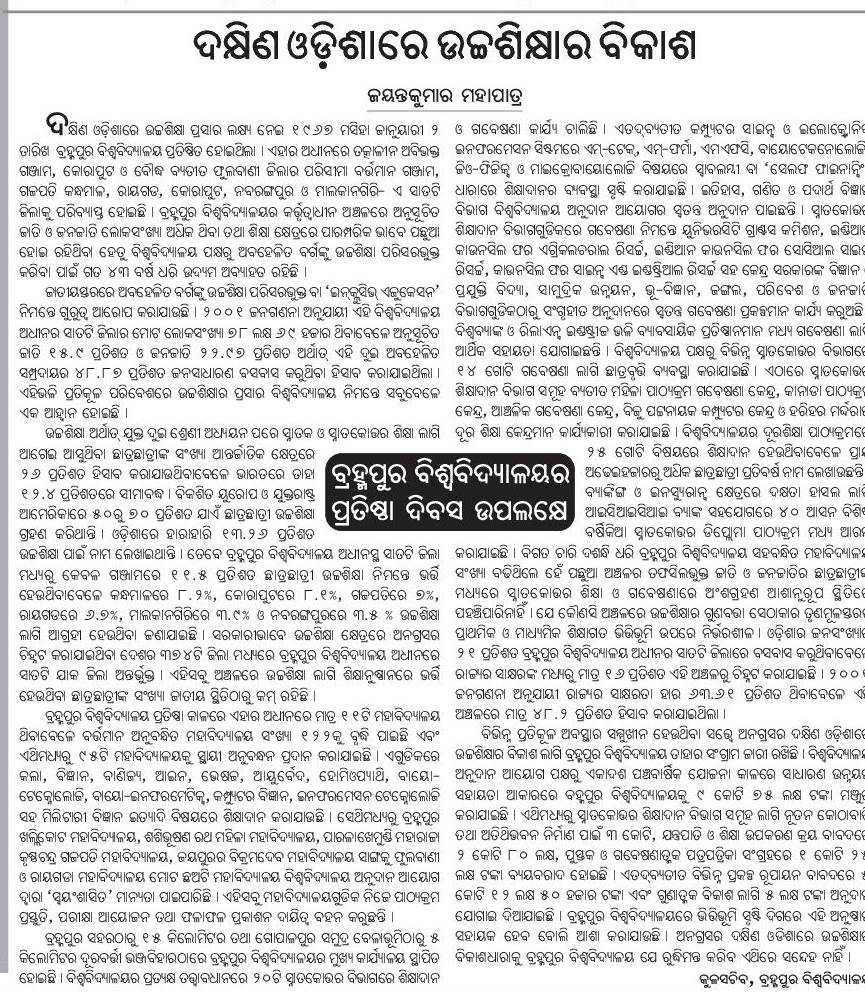
January 2nd, 2010
Following is an excerpt from the PIB http://pib.nic.in/release/release.asp?relid=56523.
Autonomous Institutions: There are seven existing autonomous institutions under Department of Biotechnology namely National Institute of Immunology (NII), New Delhi; Centre for DNA Fingerprinting and Diagnostics (CDFD), Hyderabad; National Centre for Cell Science (NCCS), Manesar; National Institute of Plant Genome Research (NIPGR), New Delhi; Institute of Bioresource and Sustainable Development (IBSD), Imphal; Institute of Life Sciences (ILS), Bhubaneswar. Recently, Rajiv Gandhi Centre for Biotechnology (RGCB), Thiruvananthapuram has been taken over from Government of Kerala. These institutes have generated 382 publications, 24 patents granted/filed, 9 patents in pipeline and 13 technologies were developed.
Establishment of new breed of institutions in critical areas has been one of the major strategies of 11th plan. Cabinet has approved setting up of institutions namely Institute for Stem Cell Science and Regenerative Medicine, Bangalore; National Agri-food Biotechnology Institute with bioprocessing plant Cluster in Knowledge city at Mohali; Translational Health Science and Technology Institute (THSTI); Regional Centre for Biotechnology Training and Education under the auspices of the UNESCO, Faridabad and Institute of Biomedical Genomics in Kolkata and efforts are being made to establish institutions. In other proposed new institutions, National Institute of Animal Biotechnology, Hyderabad has been approved by EFC.
Regional biotechnology clusters , around the new institutions are being planned to promote innovation and discovery. These are the Translational Health Cluster at Faridabad, the Agrifood Cluster at Mohali and the Innovation Cluster at Bangaloore. Together, it is hoped that these will become the technology and innovation gateways of India.
December 31st, 2009
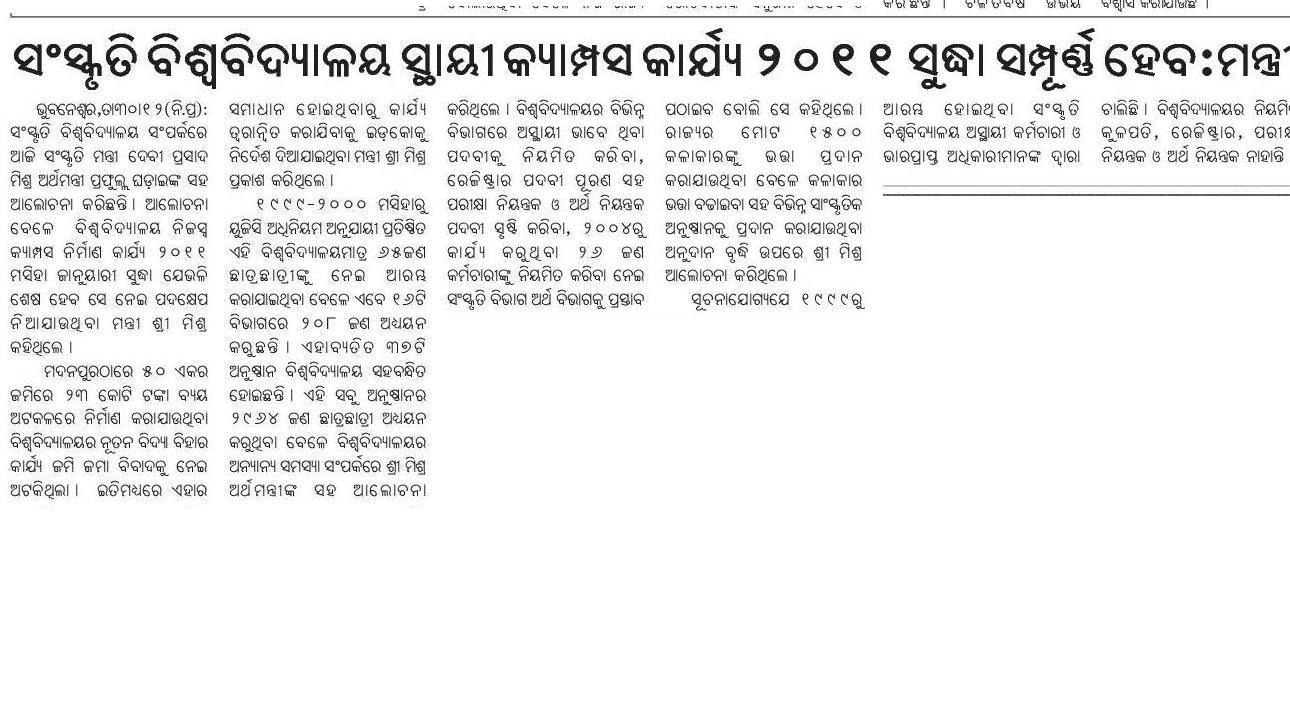
December 31st, 2009
Following is from a report in Indiaedunews.
Proposed Central varsities in two remote areas of the country – Bihar and Kerala have received a denial from the Human Resource Development (HRD) ministry to host new Central universities for their states.
Far-flung Motihari and Kasargod in Bihar and Kerala respectively do not qualify up to the desirable standards for a site to be constructed for such universities as they lack the physical and social infrastructure to proceed.
The ministry is learnt to have asked the two states to come up with an alternative location for the set up.
The Central government clearly opposed the stand of the State governments, academics and development votaries who stood by the decision to host the new varsities in the remote areas of the country, which will boost its economy and help in creation of new and additional infrastructure.
The necessary conditions needed for the set up of a university in both Motihari nad Kasargod area are not feasible due to poor access, connectivity and lack in infrastructure in the form of good schools which are vital to attract quality faculty in the varsity.
While Kasargod, located in the northern part of Kerala suffers serious connectivity issues, Motihari in East Champaran in Bihar is considered a backward region.
The ministry felt that constructing such institutes in these areas will mar the whole criteria of establishment since they would not be able to provide quality education through qualified teachers, as they would not be interested to enter in such areas.
A similar problem has been faced by the Central University at Koraput in Orissa which is facing a serious faculty crunch in terms of quality.
Lack of adequate facilities, along with absence of good schools and hospitals are proving to be deterrents for the faculty who are unwilling to shift over to such areas.
In regards to Koraput, Orissa government needs to take some proactive steps quickly; before the problem becomes worse. Earlier we suggested the following.
- Start a daytime train between Bhubaneswar and Koraput. The distance between them is 679 kms. (Note that Koraput has daily overnight trains to Bhubaneswar and Howrah and a new daily train to Rourkela has been announced in this year’s budget.)
- Start an intercity between Visakhapatnam and Jeypore via Koraput. (Distance is 258 kms.)
- Open a knowledge park of 200 acres near the central university. This knowledge park should contain an STP, and other amenities. the state should invite trustees of some of the top private engineering colleges to establish educational institutions such as engineering colleges in this knowledge park.
In addition, the state should vigorously pursue the proposed airport in Jeypore.
December 31st, 2009
I knew about classes starting in the college of engineering in Bhawanipatna but somehow I missed this news earlier. The following news item in Dharitri provided the tip.

Looking in the web I found the following two documents in regards to College of Agriculture, Bhawanipatna.
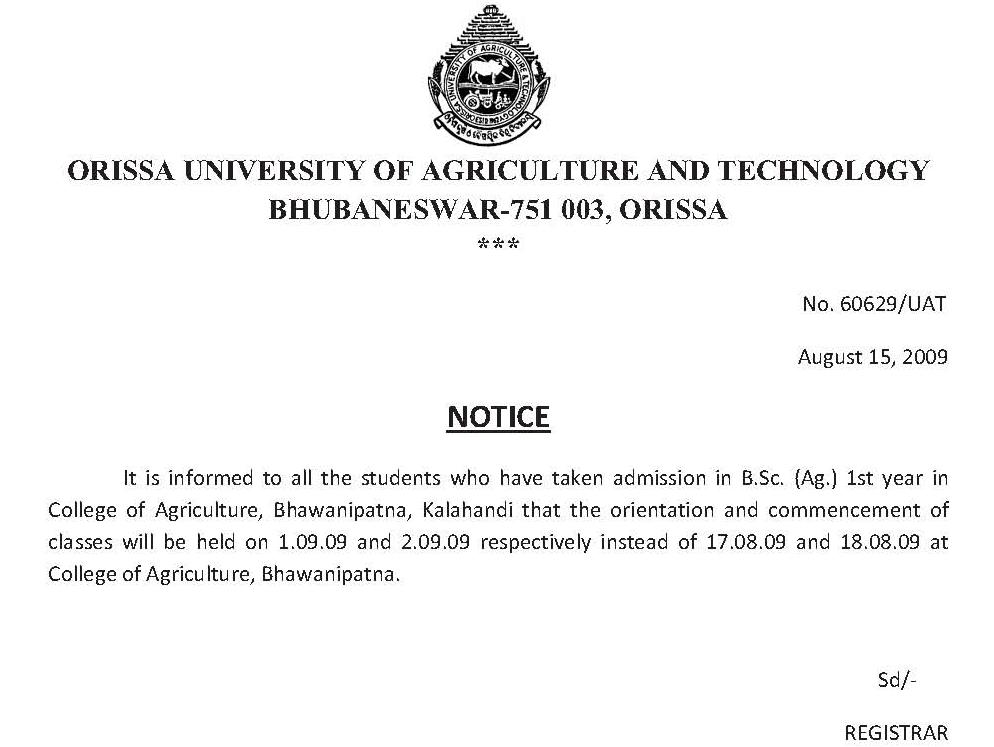
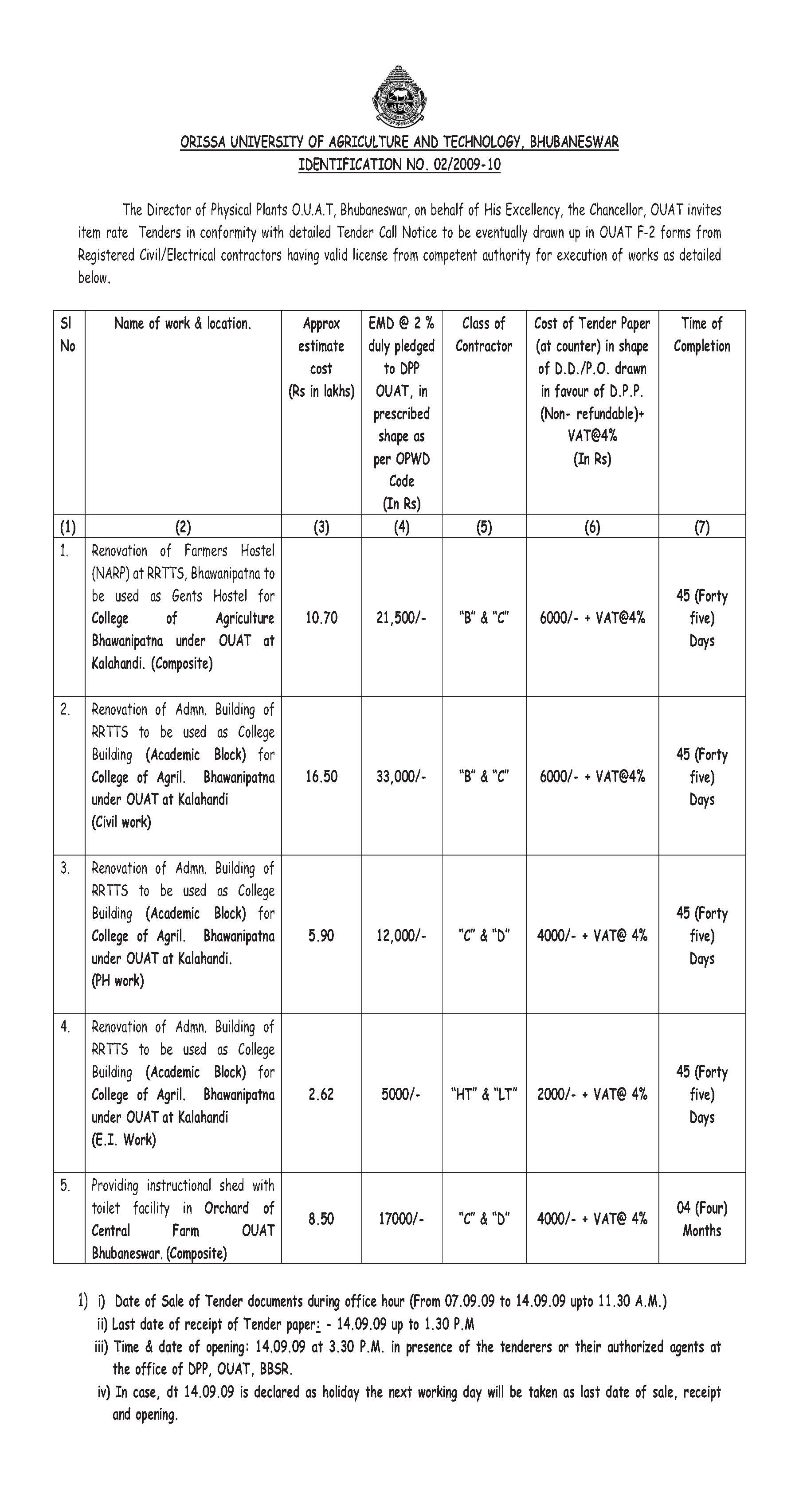
December 30th, 2009
Following is from Samaja.
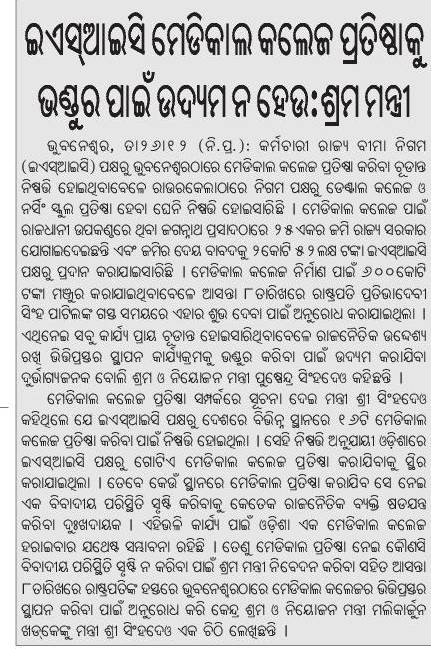
This creates an interesting situation. On one hand Rourkela is really the right location for the ESIC Medical college; but on the other hand changing of an already announced location can be dangerous in that it opens up other attempts to change other locations. No announcement of a location will be safe as people from other aspiring areas will keep trying to change it and some of that may result in instability and chaos.
While ESIC medical college case is a very very special case, and we tried to make that case, it seems to be very difficult to make people understand that. Even we have failed in that in these pages.
That may be one of the reasons Orissa government is being stubborn on the ESIC Medical college case.
As the Telangana case illustrates how one decision can have snowball effect on the rest of the country, unless the ESIC case is carefully handled (by all sides) it can create chaos across the state.
December 27th, 2009
Following is a lecture announcement in New York for 14th December 2009. It is excerpted from the page http://cfa.aiany.org/index.php?section=calendar&evtid=1024.
Mon 12.14.2009








CES LUs 1.5; HSW 1.5
When: 6:30 PM – 8:00 PM MONDAY, DECEMBER 14
Where: 19 Washington Square North
Speakers:
Adam Gross Design Principal, Ayers Saint Gross
Pawan Agarwal Civil servant in the Indian Government and author of Indian Higher Education, Envisioning the Future
The 21st Century Campus Series
NYU Abu Dhabi joins a small number of complete universities developed in the 21st century. The series will highlight both campus design and the ideas about education these plans embody. We are interested in the communal ideals the campuses stand for, the challenges associated with community building in the 21st century, and the intercultural agenda universities are forging with their host cities and regions. The lectures will take place at 19 Washington Square North, the gateway to NYUAD in New York City.
This series is co-sponsored by the AIA New York Chapter.
CES LUs 1.5; HSW 1.5
Lectures are free and open to the public, but seating is limited.
Please RSVP by email to 19wsn.rsvp@nyu.edu.
This second lecture in the series, on Vedanta University, Orissa India, will feature:
Adam Gross, Design Principal, Ayers Saint Gross, Inc.
Pawan Agarwal, Author of Higher Education in India: The Need for Change (2006)
December 27th, 2009
Update: Additional coverage at http://niser.ac.in/docs/2009/pmvisit-27-12-09.php.
Following is from http://pib.nic.in/release/release.asp?relid=56479.
I am delighted to be here today to participate in the foundation stone laying ceremony of this National Institute of Science Education and Research. The institute symbolizes our commitment to the development of Odisha and its people. It also symbolizes our commitment to the cause of education, and particularly to science education.
We recognise the important role that education has to play in our development process and our steady progress towards being a modern knowledge society. In the last about five years our government has undertaken a massive expansion and improvement of our education system at all levels. But we realize that we need to do much more.
In the area of science education particularly, I share the concern that our best minds are not turning to science. We must find ways of making science more attractive to our youth. We must improve the quality of teaching in science and mathematics at the school level. At the university level we must ensure better infrastructure, high quality faculty and greater interaction between academia and industry.
Since independence, there has been a great deal of progress in our Science & Technology system. This is evident from the success of the mission-oriented Science &Technology agencies, like the family of Department of Atomic Energy institutions, that have made our nation proud. We are committed to ensure operational autonomy, including in matters of appointments, to various institutions of excellence under the Department of Atomic Energy as is the case with some other scientific institutions of eminence in India.
I am also aware that we need to increase our expenditure on Science & Technology from its current level of 1% of our GDP. This is about half of the level of developed countries. The Government is committed to increasing Research & Development funding and for the last few years, we have been allocating larger budgets in this area. But I also expect the private sector to do more for Research & Development. We also need more public- private partnership in Research & Development in all areas of Science & Technology.
One way of making careers in science and technology attractive would be to improve remuneration and ensure the integrity of the selection process. It is well known that the initial starting salary for scientists with a PhD in India is often lower than those of Engineers, Doctors and Management graduates. It is obvious that if talented young people are to be retained in science, scientists have to be treated differently than other Government employees in service and salary matters.
It is our expectation that the National Institute of Science Education and Research will produce scientific trained manpower of a very high quality which could directly find placement across the country. There will be greater emphasis on branches of science relevant to the Department of Atomic Energy, which also cater to better exploitation and utilization of Odisha’s natural resources. Odisha’s mineral and marine resources will be taken into consideration in designing training programs for students here.
We expect NISER to be an institute at par with the best in the country in terms of facilities and faculty. It will have a research to teaching load as practiced in the best universities in the world. This will ensure world class education and also attract the best researchers. It will have world-class experimental facilities in all the current and emerging branches of science including physics, chemistry, modern biology and environmental sciences. I am confident that the National Institute of Science Education and Research will become an eminent institute for science like TIFR and IISc.
Let me end by wishing the National Institute of Science Education and Research all the very best in the years to come. Odisha has produced many outstanding scientists like Jogesh Chandra Pati. I hope this institution will produce many more great men of science. I also wish all of you all success in your efforts to make India stronger in Science and Technology.”
*****
AD
December 27th, 2009
Following is an excerpt from a report in expressbuzz.com.
There is an unprecedented response for tenders for the construction of new All India Institute of Medical Sciences (AIIMS)-type medical institutions in Patna, Raipur, Bhopal, Bhubaneshwar, Jodhpur and Rishikesh.
Sources in the Ministry of Health and Family Welfare sais around 160 construction companies joined the bidding making it more competitive.
Thanks to the incentive package, if the construction of the institute is completed within the stipulated time or little in advance of the scheduled time, the company would get benefit of Rs 10 crore at one stroke. As per the detailed project report, construction cost of each institution, which comprises the medical colleges and the hospital, is around Rs 300 crore and for the all the six institutes, the cost would be around Rs 1800 crore.
December 26th, 2009
Earlier I wrote about people getting together and offering land for a university, a branch campus, or a new institute in Orissa. This is exactly what has now transpired in Delhi. I hope people in various parts of Orissa learn from this. Following is an excerpt from a report about the Delhi farmer’s offer.
… A delegation from Delhi’s villages called on Chief Minister Sheila Dikshit on Monday and presented to her a resolution offering 540 bighas of land in the Ghumanhera village in Najafgarh for opening of a State university.
A memorandum seeking opening of a new general university under the Delhi government and naming it after former Prime Minister Rajiv Gandhi was submitted to Ms. Dikshit …
They said that opening of a new general university under the Delhi Government would benefit the farmers of Delhi as it would also help in implementation of the OBC reservation list under which the Jat community is covered.
Dr.Kumar had earlier also raised this issue with the Prime Minister Manmohan Singh for inclusive development in the rural areas by asking to give a portion of the developed land to the farmers from whom it is acquired, said that the meeting was a historic landmark as the farmers have willfully offered to give the Gram Sabha land for a noble cause.
… Sibal had however given a green signal to the plea, in writing to Dikshit that, the government should consider the plan and avail the help of the Centre to set up a new state university providing incentives to the states during the 11th Plan since the Guru Gobind Singh Indraprastha University does not have seats in general higher education, in which a majority of students from the rural areas of Delhi are interested.
Following the interaction, Dr. Kumar said the Chief Minister declared that she would soon work on forming this new university and thanked the farmers for offering to give their land to Delhi Government for the purpose.
The underlined parts above are important points. (i) Returning part of the developed donated land to the farmers, which by then is multiple times worth the original land, is a win-win situation. (ii) General Universities are important and no matter the existence of NIT and BPUT, Rourkela, still the second largest metropolitan area of Orissa, must have a general university at the earliest.
December 23rd, 2009

Update: Samaja also reports on it.

December 22nd, 2009
Following is an excerpt from a report in livemint.com.
A two-and-a-half-year-old proposal by the ministry of information and broadcasting (I&B) to upgrade the Indian Institute of Mass Communication (IIMC), a 45-year-old state-run media school, into an international university may be approved.
The I&B ministry is preparing a draft cabinet note on the subject in consultation with the institute, according to a report of the standing committee on information technology tabled in Parliament last week. …
The enhanced status will let it offer bachelor’s and postgraduate degrees instead of the postgraduate diploma it currently offers.
The I&B ministry has also asked the Jawaharlal Nehru University (JNU) in New Delhi for facilities since the media institute is currently located on the JNU campus. The university status will also cover IIMC’s campus at Dhenkanal in Orissa.
December 22nd, 2009
I was going through NIT Rourkela’s website. Although it has been always ranked pretty high (good research ranking, high ranking by India Today) among engineering colleges in India, over the last few years it is turning into a comprehensive university with new departments and programs. Prof. Sunil Sarangi has done wonders since he has arrived as the director of NIT Rourkela. Following are some of the highlights of the unique programs, new programs and new departments.
Note: Among the above departments, the Applied Mathematics, Chemistry and Physics departments are not new but I think the M.Sc programs are new; I could not find when exactly they were started.
As one can notice from the above, one can do degrees in Molecular Biology or Humanities at NIT Rourkela. Soon one can pursue an MBA. This is really wonderful and kudos to Prof. Sarangi for making this happen.
In August this year when I met Prof. Sarangi in Orissa I broached the topic of having a medical college at NIT Rourkela. He was not opposed to the idea, but was worried that with only 1-2 years left in his tenure at NIT Rourkela, he would not be able to make it happen in that short time. I hope a way is found so that Prof. Sarangi stays for another 5 year term at NIT Rourkela. I am told every one likes him and respects him at NIT Rourkela. We should write him and thank him for all that he has done for NIT Rourkela, request him to stay longer in Rourkela and we should do something (perhaps write to CMO and MHRD) to give him another 5 year term. We should request Prof. Sarangi to start a medical college at NIT Rourkela. His parent institution, IIT Khragpur is starting one in Kharagpur, so if he is given time, he will be able to do it. Another program that NIT Rourkela should be encouraged to establish is "Architecture and Town Planning". (In this regard, NIT Warangal leads the pack of NITs in planning for a medical school and a law school.)
For our readers with Rourkela connection please spread the word about the availability of science, business and humanities programs at NIT Rourkela so that good students and faculty join these programs. Also, some of you students, go and pursue higher degrees (PhD) and come back and join NIT Rourkela and to the others become an entrepreneur and open companies in Rourkela.
Another good thing about all of these is that with the new VC at VSSUT Burla, who is also from IIT Khragapur and a good friend of Prof. Sarangi , a similar transformation can be expected at VSSUT Burla. Already, a new department of Humanities is being made at VSSUT Burla. VSSUT Burla has advertised for new faculty positions and its VC has mentioned some of his new plans. In an interview to TOI he is reported to have said:
Our priority will be to make the institution as one of the best of the country and for this we are planning to introduce few new branches of engineering courses. Textile engineering is one among them which will help to strengthen the development of the Sambalpuri fabric. We also plan to introduce Nano-science technology, Bio-medical engineering and surgical engineering soon”, the vice chancellor Dr Tripathy told.
December 19th, 2009
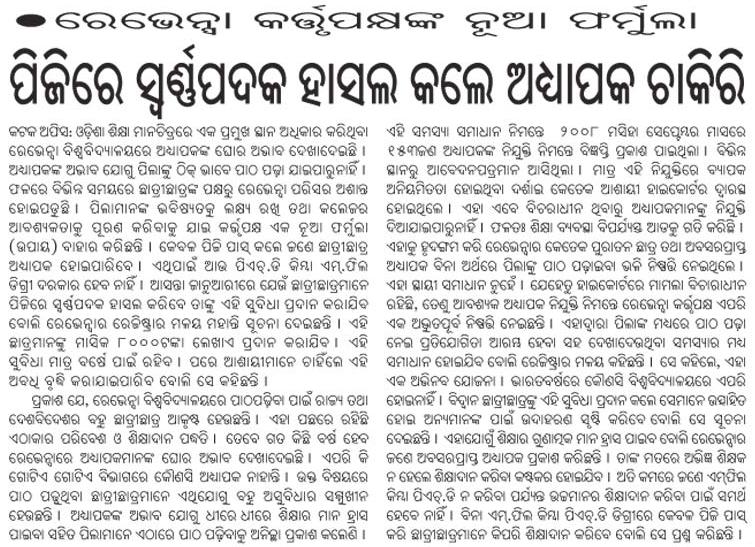
December 18th, 2009
Following is an excerpt from a report in Times of India.
Sibal, who was speaking at a Singapore Symposium here, said both India and Singapore will cooperate in setting up 14 innovation universities in India.
India needs modern universities to bridge the huge skill shortage gap and Singapore can be the best country to partner with in this area. Infrastructure, education, and skill development are the potential areas of cooperation between the two countries," he said.
Sibal said India is grappling with the challenge of building architecture for 21st century cities and cooperation with Singapore in this sector can be beneficial in identifying a possible solution.
Singapore has achieved an enormous level of excellence in innovation and India is rich in skilled manpower, and greater cooperation between the two countries can result in win-win opportunities for the two countries," he added.
Sibal said India has very recently initiated steps to reform the education sector and added that positive results are expected by 2014.
Following is excerpted from a PTI report in Hindu.
With a large number of rural people migrating to urban areas, the government is planning to set up an innovation university dedicated to study and research in sustainable city development, HRD Minister Kapil Sibal said today.
This university will work on all issues, including city planning, water management, urban transport, housing and energy, he said at ‘The Singapore Symposium’ here.
The government will set up 14 innovation universities. One of them could be on the area of city development which will work on technology solutions for urban planning,” he said.
Mr. Sibal said that urban areas in the country are yet to be developed. They suffer from myriad problems starting from power crisis to drainage and water management. The government is looking for partnerships with various agencies for starting such innovative universities.
Why cannot we have a partnership with Singapore to move forward?” he asked.
The government is in the process of setting up 14 innovation universities aiming at world class standards. Some of these universities would be set up in partnership with foreign institutions.
After US and UK, Singapore is the third country where the Inidan government has mentioned possible partnership/co-operation for developing its proposed innovation universities.
December 16th, 2009
Next Posts
Previous Posts








